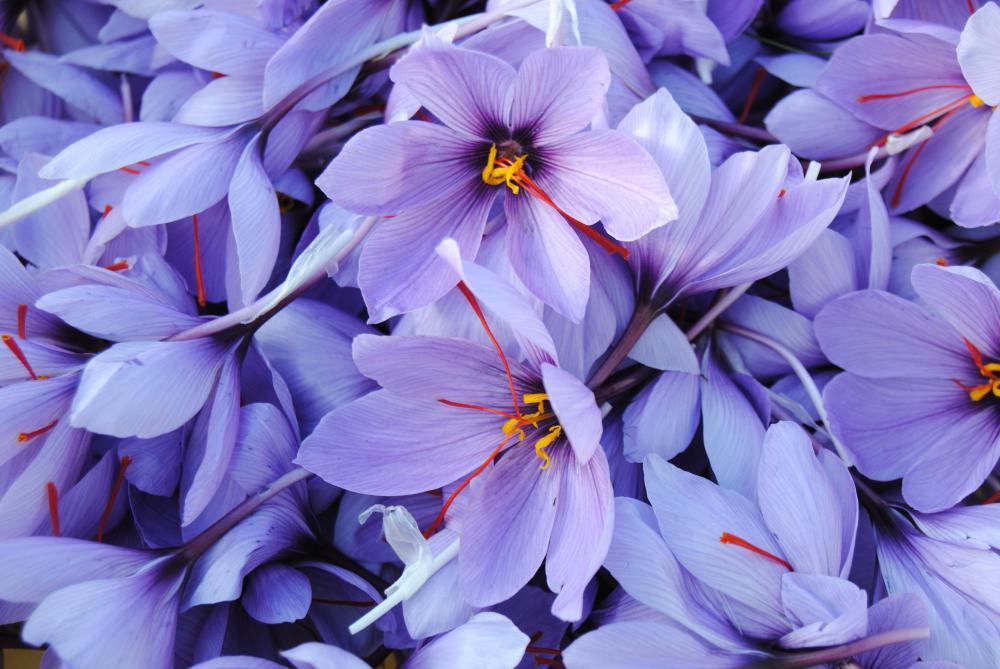At HomeQuestionsAnswered, we're committed to delivering accurate, trustworthy information. Our expert-authored content is rigorously fact-checked and sourced from credible authorities. Discover how we uphold the highest standards in providing you with reliable knowledge.
How Do I Grow Saffron Bulbs?
Saffron is a yellow-orange spice that comes from the bulb of the Crocus sativus plant species. Saffron is best grown in the home garden in a sunny spot where the soil drains well. The bulbs grow well in hot, sunny climates or during the dry warm season. In rainy climates, saffron bulbs can be grown indoors.
The typical planting time is midsummer for saffron bulbs. A spot in a sunny garden bed is best for these heat-loving flowers. Good soil drainage is critical as well, and rocky soil with low nutrient levels is ideal for flowering and saffron production. The bulbs thrive in soil with a pH between 7 and 8.

The bulbs should be planted in holes deep enough so that each one is covered by 6 inches (about 15 cm) of soil. A spacing between plants of 6 inches (about 15 cm) leaves enough room for each plant to develop and produce flowers. When planting saffron bulbs, the roots should be at the bottom of the hole with the stem facing up.
When planted in midsummer, saffron bulbs will bloom that same fall. When the flowers open, the stigma can be pinched off from the center of the flower. The fine orange dust is then collected in a jar for use in the kitchen.

Once established, saffron bulbs continually produce new bulbs, called offsets, as a means of self-propagation. To propagate saffron bulbs in the garden, the bulbs can be dug up and replanted. Late fall or early winter when the plant foliage dies back is the best time to dig saffron bulbs.
Not just for the herb and spice garden, saffron has delicate flowers that add ornamental value to the landscape. This bulb is well suited for mass planting in sunny areas or in a rockery. The upright nature of the plants make saffron flowers well suited for use as border plants along pathways and garden beds.
This heat-loving bulb, native to Southern Europe and West Asia, grows best in climates that have long, hot growing seasons. In cooler climates, saffron can be cultivated in the home garden but generally will not produce enough for commercial growing. Areas with wet rainy summers are not well suited for growing saffron bulbs.
In damp rainy climates, saffron can be grown indoors or in a greenhouse. A soil medium that drains well works best, such as one formulated for cacti and succulents. A temperature of 65°F (about 18° C) or above encourages saffron bulbs to grow and bloom successfully.
AS FEATURED ON:
AS FEATURED ON:












Discussion Comments
I did not dig up my bulbs this year and the still have 6 inch greens growing from them. Can I just leave them or cut them back?
@browncoat - I always thought that there was an easy enough solution for the fact that it's so difficult to pick saffron.
Just plant the bulbs in beds that have been raised to waist height.
I know this would cause initial expense, but if you made the beds really well, you'd just have to walk along and pick the stamens easily and quickly, without hunching down.
They like rocky soil, so they must need good drainage. Having raised beds would also help with this.
I don't have the land to try this, but if I ever did I would give it a shot. They are gorgeous flowers anyway, so it definitely wouldn't do any harm to have some rows of them in the garden.
@pleonasm - The problem with growing saffron commercially is that it is back breaking labor. There is no way to pick the stamens without using your hands and each one is only a few grams.
Considering how many hours it can take to harvest a kilo of saffron you begin to understand why it is so expensive.
That's not to mention the expense of buying and planting the corms in the first place, and how long it takes them to multiple.
And the market for saffron isn't huge either. It's not an easy spice to sell as it isn't all that tasty and is more about a subtle flavor and the color it gives to food.
So, too much in the market and the prices fall making it even less worth while. As it is, it can be close to minimum wage to grow it as a crop.
I think most small farmers keep it as a special, supplementary crop but don't rely on it as a primary crop, since in order to make that commercially viable you need a huge amount of land.
I've always been fascinated with the idea of growing saffron. The flowers are so pretty and of course, the spice is worth so much money!
You really have to have a particular kind of micro-climate though in order to get the bulbs to grow properly. They need freezing winters and warmish summers.
And there are so many established places which grow saffron, you also have to make sure you have the resources and connections to sell the crop once you've grown it.
I think there are often growers associations in areas where it is possible to grow saffron. And growing saffron bulbs for sale might be almost more lucrative than growing the saffron itself, as quite a few small farmers are realizing the potential of this crop and are wanting to buy the bulbs.
Post your comments